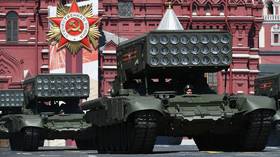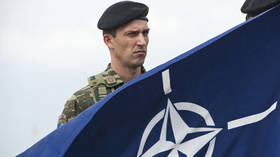A misunderstanding between NATO & Russia could cause a catastrophe

In the past month, an alleged “build-up” of Russian military forces close to Ukraine has led to numerous claims that Moscow is planning to invade its neighbor. To head off this supposed danger, Western states have this past week threatened President Vladimir Putin's government with “massive consequences” if it orders an offensive.
The Kremlin has consistently denied it is preparing an attack, and instead has demanded NATO pledge that it will not expand any further to the east. Ukraine’s long-held ambitions to join the bloc, it says, would cross a “red line” and would provoke a stern response.
In the West, Russian complaints about NATO expansion evoke little sympathy. The bloc is a purely defensive organization, goes the argument. Besides which, it is said, the alliance’s only borders with Russia consist of two short strips of land, along the Estonian/Latvian and Norwegian frontiers. Given Russia’s size, this hardly poses a severe threat, it is claimed.
Against this, others note that NATO’s aircraft are just a few minutes from the country’s second city, St. Petersburg. When the Soviet Union placed rockets in Cuba in the early 1960s, it was enough to make the US threaten war. One can hardly expect the Russians to react with complete equanimity.
In his celebrated “Hypotheses on Misperception,” Jervis noted that we all need to “develop an image of others and of their intentions,” but that this image is often faulty. Jervis drew up 13 hypotheses to explain why. A number of them are very relevant to the current crisis of Russian-Western relations.
The first problem, says Jervis, is that “decision makers tend to fit incoming information into their existing theories and images.” Furthermore, “there is an overall tendency for decision-makers to see other states as more hostile than they are.” Put these together and you have a toxic cocktail: if your existing theory is that another state is hostile, you will interpret any information you receive about that state in such a way as to confirm its hostility.
It’s easy to see how this fits the current state of Russian-Western relations. Each side has a negative image of the other, and each therefore interprets the other’s behavior in the worst possible way. For Russia, NATO expansion is a threat; the Maidan revolution in Ukraine was a plot engineered by the West; and so on. For NATO, the “annexation” of Crimea was the first step in a Russian plan of aggression against Europe, and Russian military exercises are not really exercises but a preliminary to a massive invasion of Ukraine.
Of course, there are other perfectly innocent explanations for all these things, but as Jervis comments, “actors tend to overlook the fact that evidence consistent with their theories may also be consistent with other views.” The Russian “build-up” of troops near Ukraine is much more likely to be a warning to Ukraine not to launch an assault on rebel Donbass than to be a preparation for an invasion. But the fact that it is consistent with Western perceptions of Russia as aggressive is enough to mean that this more realistic theory is never even considered.
This in turn reveals another problem. A lot of international politics is about signaling, but as Jervis points out, “when messages are sent from a different background of concerns and information than is possessed by the receiver, misunderstanding is likely.”
Take, for instance, NATO’s plans for missile defense systems in Europe. These are notionally a response to the threat of Iranian ballistic missiles. Russia, though, is worried that these systems might weaken its own deterrent capability, making it less able to retaliate in the event of a strike and tipping the scales of mutually assured destruction. To Russia, NATO’s concerns about Iran are ridiculous. But to NATO, Russia’s concerns are equally silly. The two sides thus end up talking past each other.
Or take another example. By deploying its forces near Ukraine, Moscow is signaling Kiev not to assault Donbass. But the message the West is getting is a different one: Russia is poised to attack. Likewise, the West thinks that by sending troops to the Baltic States, and threatening Russia with “massive consequences,” it is deterring Russian “aggression.” But the message that Moscow is getting is that the West is hell-bent on a confrontation. The signals sent are not the signals received.
What makes matters worse is that, as Jervis says, “when people spend a great deal of time drawing up a plan or making a decision, they tend to think that the message about it they wish to convey will be clear to the receiver.” Similarly, “when actors have intentions that they do not try to conceal from others, they tend to assume that others accurately perceive those intentions.”
In line with this, NATO and Russia assume that because they think that their message is clear, the other must understand it. If the other is acting otherwise, the only logical conclusion is that it is pretending not to understand, in order to justify its own hostile actions.
Since NATO thinks that it should be clear to everyone that it is a defensive organization, if Moscow insists on viewing it otherwise, that is further proof of Russia’s aggressive intentions. And likewise, since Russia thinks it is obvious that it has no intention of invading Ukraine, if NATO is saying the opposite, it must be because it is looking for an excuse to take action against Moscow.
To counter this, Jervis suggests that decision-makers should be aware of their own biases, avoid tying their policies to specific theories, and be more willing to examine situations from a variety of angles. None of this is exactly rocket science, but it does point us towards what’s wrong. Rather than being open to different views, we have become locked in a theory of ourselves as innately good and those with whom we disagree as innately evil.
As a result, we exaggerate threats, misinterpret signals, and fail to recognize that the signals we send are likely to be misunderstood. When others respond differently to how we desire, it reinforces our vision of them as hostile, causing more exaggeration, more misinterpretation, and so on ad infinitum. Jervis showed us how we got on this vicious cycle. It’s now up to us to find a way off.
The statements, views and opinions expressed in this column are solely those of the author and do not necessarily represent those of RT.


0 Comments:
Post a Comment
Subscribe to Post Comments [Atom]
<< Home